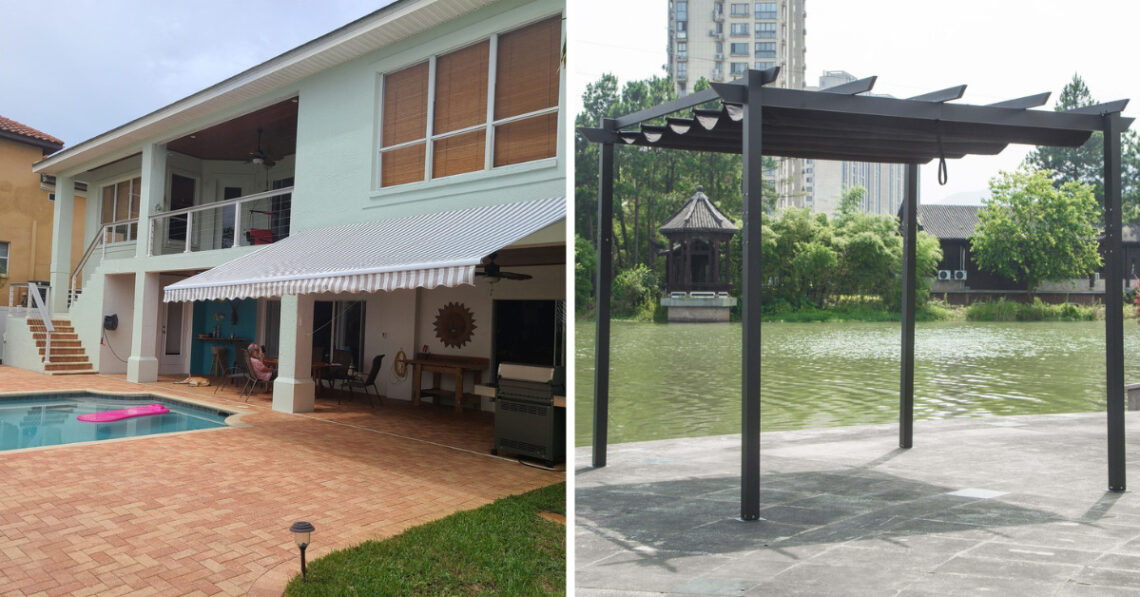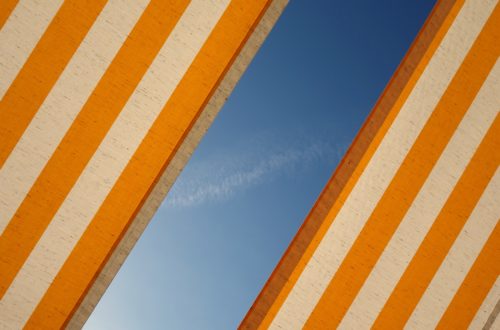When the sun is out, nothing beats lounging under a shaded area as you sip on fruity libations and chat with friends and family. While you can certainly opt for a few sun umbrellas, awnings and pergolas provide a sophisticated look to your patio, garden, or courtyard.
They’re permanent structures that can make your outdoor spaces more accessible. That said, what’s the difference between an awning vs pergola? We’re casting some light on each variation to help you transform your outdoor space into an outdoor oasis.
What Is an Awning?
First things first: What is an awning? An awning is a shade structure designed to provide sun protection and shelter, and it can transform how you use your outdoor area. Awnings, not to be confused with canopies (we’ll save the difference between awning and canopy for another article), date back to ancient times and were often used to give shade to market stalls and other outdoor entertainment venues.
The difference between a canopy vs awning is awnings are typically attached to the home, while canopies are often freestanding.
That said, there are many styles, colors, and fabrics for awnings to choose from, suitable for various tastes. They can be made from a variety of materials, including:
- Metal
- Polycarbonate
- Vinyl
Today, awnings provide the ideal space to read, dine, or spend time with loved ones while enjoying the outdoors. In addition to their aesthetic appeal, awnings can also help reduce energy costs by blocking the sun’s rays from entering the home and reducing the need for air conditioning. And with retractable or motorized options, you can easily adjust the level of shade to your liking.
The Benefits of Awnings
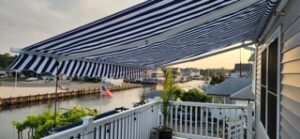
In addition to providing homeowners with shade, comfort, and aesthetic appeal, outdoor awnings offer many additional benefits, such as:
- Protection from the elements – In addition to keeping a space dry and cool, awnings can also help protect outdoor furniture from sun, wind, and rain. They may also preserve indoor furniture and carpets positioned close to windows and prevent glass doors from fading due to excessive sunlight.
- Energy savings – Awnings can also help reduce energy costs by decreasing the sunlight entering your home and limiting the need for air conditioning to keep your home cool. In addition, studies have shown that on southward windows, solar heat gain can be reduced by up to 65%, and on westward windows, up to 77%.
- Versatility – Whether it’s a window, door, or patio, the great thing about awnings is their versatility. In addition to their use on the house, you can also install them over a deck, pool area, or even a car or RV.
Awnings are an excellent investment for homeowners who love spending time outdoors. They can help you save money on energy bills, reduce your carbon footprint, and add aesthetic appeal and versatility to your home.
Two Main Types of Awnings
There are many types of awnings on the market, each with unique features and benefits. Here are the two most common.
Retractable Awnings
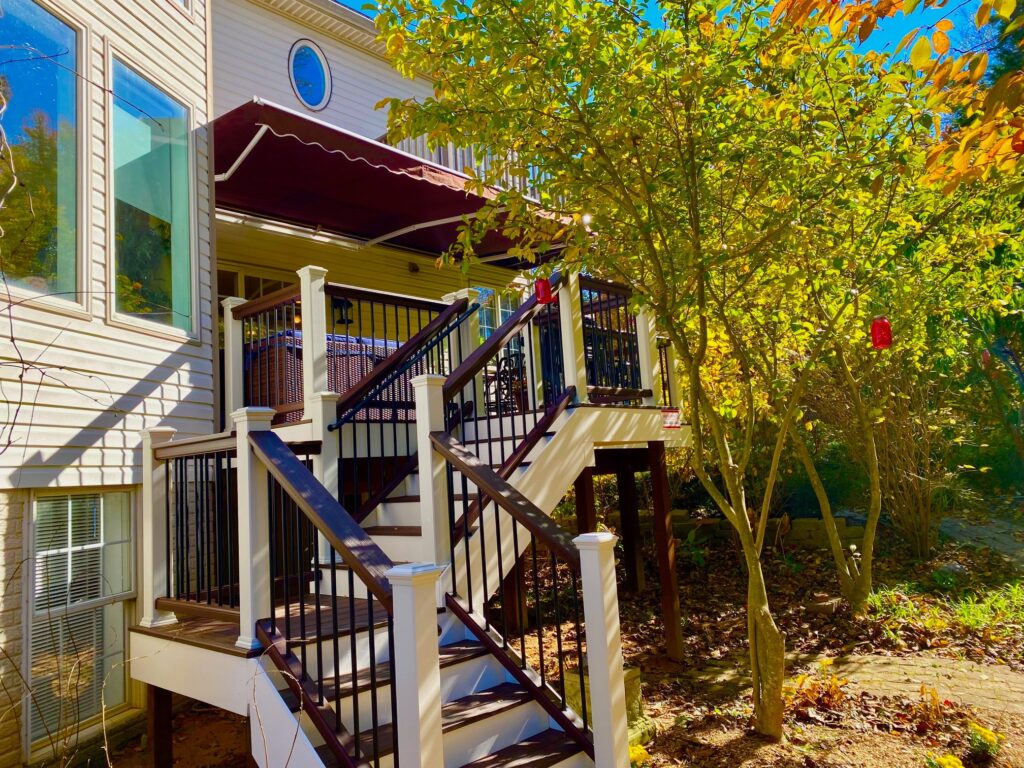
Retractable awnings are popular because they can be extended or retracted as needed, providing flexibility and convenience. Plus, the options are almost unlimited. So whether you want to sunbathe on the patio or relax and read a book in the shade––a retractable awning can help you do both.
They come in manual and motorized versions and can be adjusted to different angles to provide the most ideal space for your needs. Also, they’re incredibly versatile and can be used to protect anything from a single window to the entire side of a house.
You may be wondering, how much do retractable awnings cost? It’s important to note these types of awnings can be expensive to install and require maintenance and cleaning. And while awnings are great at the things they do best, such as heat prevention and protection from direct sunlight, they’re not built for extreme weather conditions, such as thunderstorms, heavy rain, and snowfall.
Fixed Awnings
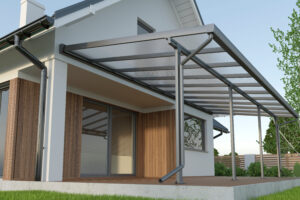
Fixed awnings are permanently attached to the exterior of a building and are not retractable. They come in multiple styles, shapes, and sizes and can be made from various materials.
Some benefits of fixed awnings worth noting are:
- Sturdier construction
- Customizable (build-to-order options)
- Require minimal maintenance
That said, you don’t have the same flexibility as you do with the retractable versions. Typically, that’s why you see fixed awnings more commonly over doors, walkways, windows, and alcoves. Plus, the steel parts can rust over time, and fabrics can fade with prolonged exposure to sunlight.
By now, you hopefully have a better understanding of awnings and the benefits they can provide.
Next up, pergolas.
What is a Pergola?
A pergola is an outdoor structure that consists of vertical posts that support cross beams and an open lattice of interlocking rafters. Pergolas are often used as support structures for climbing plants, and they can provide shade and a sense of enclosure to outdoor spaces.
Modern pergolas can be constructed from various materials, including
- Wood
- Vinyl
- Aluminum
Pergolas can also be built as stand-alone structures or attached to your house. Depending on the amount of shade you desire, there are various options, including climbing plants, bamboo rods, and fabrics that you can add to the rafters to control the amount of light that enters your space.
Benefits of a Pergola
Pergolas are a popular addition to gardens, patios, and outdoor living areas. There are many benefits of adding a pergola to your outdoor living space.
Let’s take a look at a few:
- Visual appeal – A pergola can add architectural interest and texture to an outdoor space through its height, dimension, and material. They can easily be integrated with nature to support climbing vines, such as bougainvillea, morning glory, or clematis. Or you can use the rafters and hang string lights or lanterns to create a more whimsical ambiance.
- Versatile shade – The open lattice design of a pergola allows sunlight to filter through while still providing some shade, which can be especially helpful in hot climates. Plus, there are many options to control the amount of shade. Whether adding vines, plants, bamboo rods, or fabric, each can help you achieve your desired result.
- Increased home value – A well-designed and constructed pergola can greatly increase your home’s value, especially if it complements the style and architecture of the house and its surrounding landscape. According to the New Homes Trend Institute, 58% of designers and architects said outdoor spaces and dining will be the most significant driver of home design projects over the next three years.
These are just a few benefits pergolas offer outdoor living spaces. With their versatility and aesthetic appeal, pergolas are an excellent choice for anyone looking to make their backyard more charming.
Two Main Types of Pergolas
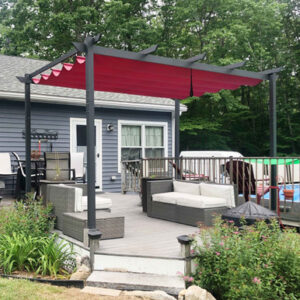
As mentioned earlier, pergolas are typically made from wood, vinyl, and aluminum. Each comes with its perks and aesthetics. To keep things simple, we’ll limit the types of pergolas to the two most essential: the freestanding and the attached.
Freestanding Pergola
Freestanding pergolas stand alone and can be made from various materials. Typically, this type of pergola provides shade near a garden, hot tub, or outside seating area separate from your home.
The roof can have an open-top or closed-top, depending on where you live and your aesthetic tastes.
Attached Pergola

This type of pergola is attached to an existing structure and can feel like an outdoor extension of your home. Often, attached pergolas extend the living space, enclosing a deck or patio. Some attached pergolas are designed to be retractable or adjustable, allowing homeowners to control the amount of sunlight or shade.
What are the Main Differences Between an Awning and a Pergola?
Now that we’ve given you a basic rundown of awnings and pergolas, let’s look at the differences between the two:
- Awnings are typically attached directly to a building, while pergolas can be either attached or freestanding. Plus, unlike awnings, pergolas are typically made of wood or other metals and consist of vertical posts that support a series of horizontal cross beams or rafters.
- Pergolas are designed to create more of a decorative outdoor space, incorporating ornamental elements such as latticework, climbing vines and plants, or lighting elements to enhance their visual appeal. In contrast, awnings are designed primarily to provide shade and protection from sun and rain.
- Awnings are generally more affordable and easier to install than pergolas. Affordable awnings can be attached to buildings using brackets or support arms. At the same time, pergolas require more extensive construction and, often, a foundation.
Both structures can create a comfortable and welcoming space to enjoy with family and friends. Ultimately, choosing between an awning and a pergola will depend on your area, outdoor space, and aesthetic preferences.
Choose ALEKO to Freshen Up Your Outdoor Living Space
Whether it’s an awning or a pergola, both can provide wonderful benefits for your outdoor living space. Awnings are an excellent choice for those looking for a cost-effective way to add shade and protection from the sunlight and rain, while pergolas offer a more decorative and visually intriguing option that can enhance your outdoor space.
Either way, ALEKO has you covered for all of your outdoor living needs. We offer plenty of stylish and affordable options made from superior parts, fabrics, and materials. Plus, all our awnings and pergolas come with comprehensive instructions that effortlessly guide you each step of the way.
Contact us and freshen up your outdoor living space today.
Sources:
Energy.gov. Energy Efficient Window Coverings. https://www.energy.gov/energysaver/energy-efficient-window-coverings
National Association of Home Builders. What’s Driving Outdoor Living Trends? https://www.nahb.org/blog/2022/02/whats-driving-outdoor-living-trends

